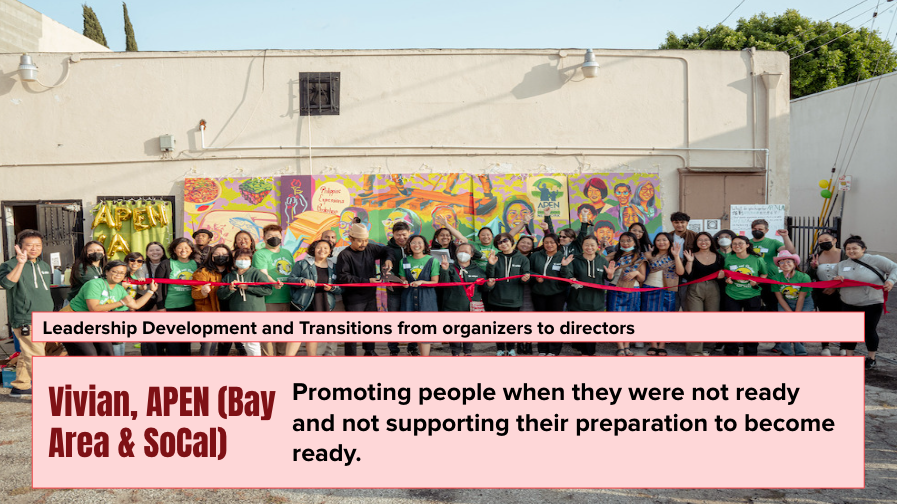Becoming More Leaderfull, Healthy & Sustainable Organizations
A key part to sustainable organizing is making sure that we have strong leadership development and transitions at all levels of the organization: members to leaders, leaders to organizers, organizers to directors and executive directors. Organizational development and infrastructure can feel daunting, but we have so much that we can learn from one another! Vivian from APEN and Suon from PrYSM shared how the lessons their organizations have learned around leadership development and transitions.
Suon from PrYSM (Providence, RI) shared that they struggled because members and staff organizers didn’t have the orientation to the entirety of the organization. Both members and organizers were only familiar with the specific programs and events they were involved in, leading to a fragmented understanding of the organization’s mission and values. For example, in one program, youth were sometimes promoted to roles without adequate clarity on their responsibilities and the connection to the organization’s overarching goals. This disconnection was evident in the Community Defensive Project, which focused solely on base building while remaining isolated from other campaigns, resulting in members feeling siloed and lacking a cohesive vision.
As a consequence of PrYSM’s structure, programs evolved into service-oriented social clubs rather than vehicles for political engagement and power building. This shift not only diluted the impact of the organization's work in critical areas like deportation defense and police accountability but also contributed to high burnout rates among organizers. The pandemic exacerbated these issues, as rapid response efforts to rising police violence diverted focus from community organizing, further complicating the clarity of PrYSM’s purpose and mission. Members often felt disconnected from the larger organizational goals, leading to disjointed engagement and a lack of direction despite an increase in membership.
In response to these challenges, PrYSM implemented several key changes to realign its focus and improve member engagement:
Hired a membership coordinator to sit with members to learn about PrYSM. This person worked to sustain these members, figure out where the members actually fit in, and help members understand that they are joining an organization, not just a program.
Removed 7 out of 10 staff because we recognized the impact of the burnout and conflict.
Narrowed the number of programs to help make space to develop a clearer understanding on what these programs fit into the mission of PrYSM.
Called in another organization, Facilitate Change, to help manage conflict and to deal with the fallout from this conflict.
With all these shifts, PrYSM been able to do much more of the actual organizing work and realign their purpose. Youth leadership has grown. Programs are much less siloed. Most of all there is clearer understanding of why PrYSM does working-class organizing.
Vivian from APEN (Bay Area & SoCal) shared about how APEN struggled with leadership development and transitions from organizers to directors because they were promoting people when they were not ready and not supporting their preparation to become ready. APEN fosters a culture of growth and collaboration, and this positive environment sometimes led to premature promotions. Although many leaders were successfully developed internally, some struggled with their new responsibilities, highlighting the need for better preparation and clearer expectations.
The consequences of this misstep affected both individual directors and APEN as a whole. New directors found themselves overwhelmed, leading to frustration among team members who lacked direction and clarity regarding their goals. This situation resulted in a scarcity mindset, where decisions were based on immediate capacity rather than strategic planning. Consequently, the disorganization impacted essential initiatives, causing delays and confusion across teams, such as the prolonged expansion of organizing membership into new areas like Los Angeles.
To address the leadership development challenges, APEN implemented structural changes focused on prevention and support systems. Key initiatives included the creation of a strategic pathways plan to enhance strategy development and organization-wide work priorities, ensuring that all team members understand how their roles contribute to the overall mission. Additionally, the organization developed a supervision manual and established quarterly roundtables to foster effective feedback and assessment processes. Clear criteria for promotions were also introduced, allowing staff to grow in their leadership capabilities before advancing to director roles, promoting a more thoughtful and sustainable approach to leadership transitions.
APEN recognized the importance of personal growth and resilience in leadership roles, recognizing that not everyone can comfortably manage the uncertainties that come with increased responsibility. To support this, coaching was made available to directors and other team members, facilitating their development in navigating difficult conversations and conflicts. By fostering an environment that encourages open communication and honest assessments of readiness for leadership, APEN aims to build a more effective and cohesive leadership structure that supports both individual growth and overall organizational success.


